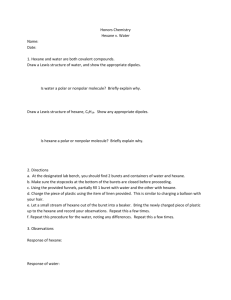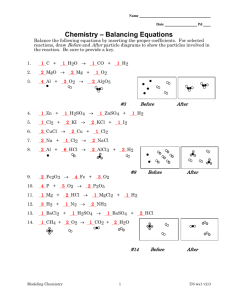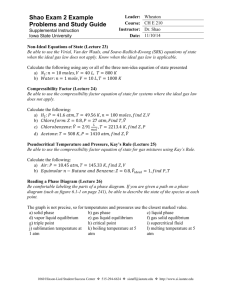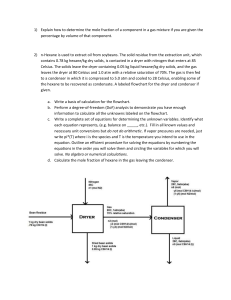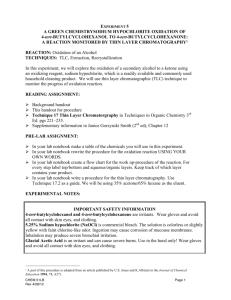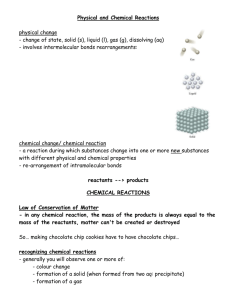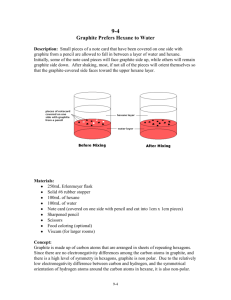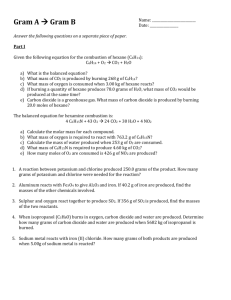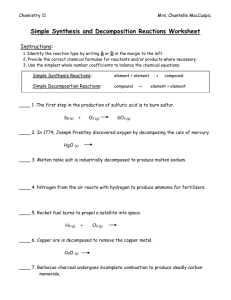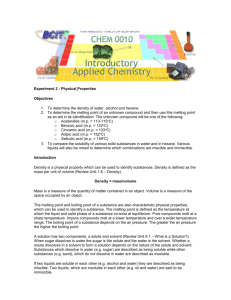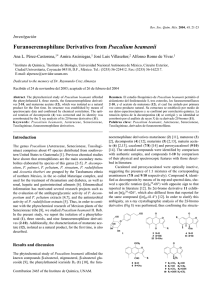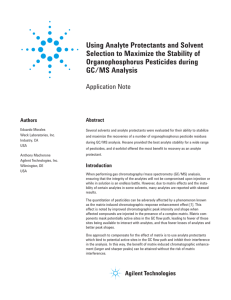CHEMISTRY PAPER 233/2 K
advertisement
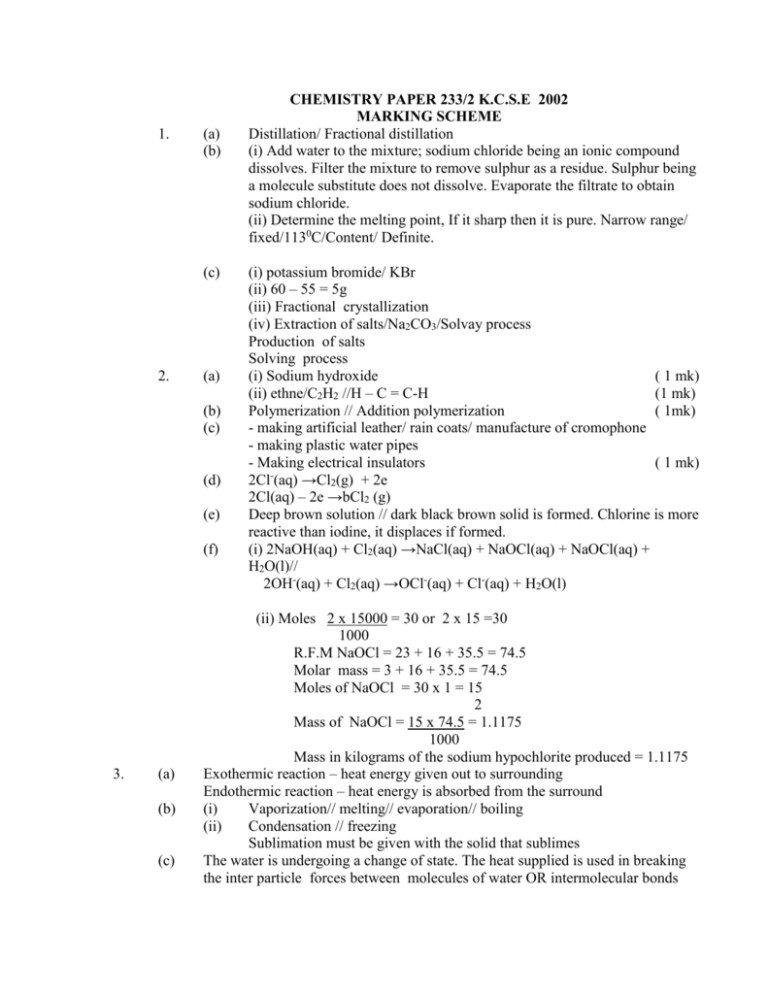
1. (a) (b) (c) 2. (a) (b) (c) (d) (e) (f) 3. (a) (b) (c) CHEMISTRY PAPER 233/2 K.C.S.E 2002 MARKING SCHEME Distillation/ Fractional distillation (i) Add water to the mixture; sodium chloride being an ionic compound dissolves. Filter the mixture to remove sulphur as a residue. Sulphur being a molecule substitute does not dissolve. Evaporate the filtrate to obtain sodium chloride. (ii) Determine the melting point, If it sharp then it is pure. Narrow range/ fixed/1130C/Content/ Definite. (i) potassium bromide/ KBr (ii) 60 – 55 = 5g (iii) Fractional crystallization (iv) Extraction of salts/Na2CO3/Solvay process Production of salts Solving process (i) Sodium hydroxide ( 1 mk) (ii) ethne/C2H2 //H – C = C-H (1 mk) Polymerization // Addition polymerization ( 1mk) - making artificial leather/ rain coats/ manufacture of cromophone - making plastic water pipes - Making electrical insulators ( 1 mk) 2Cl-(aq) →Cl2(g) + 2e 2Cl(aq) – 2e →bCl2 (g) Deep brown solution // dark black brown solid is formed. Chlorine is more reactive than iodine, it displaces if formed. (i) 2NaOH(aq) + Cl2(aq) →NaCl(aq) + NaOCl(aq) + NaOCl(aq) + H2O(l)// 2OH-(aq) + Cl2(aq) →OCl-(aq) + Cl-(aq) + H2O(l) (ii) Moles 2 x 15000 = 30 or 2 x 15 =30 1000 R.F.M NaOCl = 23 + 16 + 35.5 = 74.5 Molar mass = 3 + 16 + 35.5 = 74.5 Moles of NaOCl = 30 x 1 = 15 2 Mass of NaOCl = 15 x 74.5 = 1.1175 1000 Mass in kilograms of the sodium hypochlorite produced = 1.1175 Exothermic reaction – heat energy given out to surrounding Endothermic reaction – heat energy is absorbed from the surround (i) Vaporization// melting// evaporation// boiling (ii) Condensation // freezing Sublimation must be given with the solid that sublimes The water is undergoing a change of state. The heat supplied is used in breaking the inter particle forces between molecules of water OR intermolecular bonds (d) (e) 4. (a) (b) (i) (i) Heat of formation of FeCl2 (ii) ∆H1 + ∆H2 OR ∆H1 = ∆H3 - ∆H2 OR ∆H2 = ∆H3 - ∆H1 Butane because more bonds are formed on combustion of butane hence more heat released OR Butane has a large molecular mass / carbon atoms OR Butane has highest percentage of carbons. E; its ions have the greatest tendency ( + 0.85Y) to accept electrons// has reduction potential // strongest oxidizing agent F F2+ (aq) + 2e →F(s) G 2+ G(s) →G (aq) + 2e (ii) (iii) (c) 5. (a) (b) To complete the circuit // maintain charge balance // Enable ions to move to cell too (i) The blue green colour of the solution fades; Cu2+are removed from the Solution (ii) The two gases are chloride and oxygen; initially Cl- are at a more higher Concentration of Cl- goes hence the OH- is discharged reading to production of oxygen gas 2Cl-(aq) →Cl2(s) + 2e 4 CH-(aq) →2 H2O(4) + O2(g) + 2 //e (iii) J; Negativity charged ions (aq – and not OH – can only move to the anode // anode is the charged hence attract Cl- and HO (i) Hydrogen // H (ii) carbon //C (i) Extinguishes // put off // goes off // want out // Die; CO2 and Water vapour, which do not support combustion, accumulates around the supply of oxygen (ii) Mass increases; water vapour reacts with CaO and forms Ca (OH) Ca (OH)2 reacts with Co2 to produce CaCO3 CaO(s) + H2O(l) →Ca (OH)2(s) → CaO reacts with moist CO2 Ca (OH)2 + CO2(g) →CaCO3(s) + H2O (iii) Oxygen and Nitrogen Helium, Neon argon; Accept a name of inert gas 6. (a) (iv) To absorb excess water vapour // moisture (v) Sodalime // NaOH- and CaO // KOOH // Caustic potash // caustic soda Milachile // Copper pyrites // Chalcasite // Chalcopyrite // Bonile // a zurile (b) (i) (c) 7. (a) Hydrogensulphide // H2S Reagent Q ( 1 mk) Sodium Carbonate // NaCO3 // NaHCO3 // Potassium carbonate // Solid R Copper (ll) Oxide // CuO (ii) CuCO3(s) →CuO(s) + CO2 Step 4 Green solid dissolves to form blue solution There is effervescence // bubbles Step 7 Black solid dissolves to form a blue solution (i) Tin // Sn (ii) Ornaments // medals // metal bearings in machines // jewels // spear head // making coins // gear wheels // rims of car // clocks springs // electric contact. Write the structural formula of: (i) Methanol ( 1 mk) H I CH3OH OR H - C - OH I H (ii) Methanoic acid ( 1 mk) O HCOOH OR H - C - OH Write the equation for the reaction between methanoic acid and aqueous sodium hydroxide (1 mk) (b) (c) (d) - NaOH(aq) + HCOOH(aq) → HCOONa(aq) + H2O(aq) (i) Name the product formed when methanol reacts with methanoic acid Methylmethanoate // HCOOCH3 // H – C – O – CH3 (ii) State one condition necessary for the reaction in © (i) above to take Place add conc. H2SO4 Heat to 1800C // warm // heat (i) Describe one chemical test that can be used to distinguish between hexane and hexane Use a bromine water // acidified potassium permanganate If hexane they will be decoloured If hexane no decolourisation (ii) State one use of hexane Fuel // solvent // manufacture hexanol // hexanoic acid, hexanol (iii) Hydrogen gas reacts with hexane form hexane. Calculate the volume or hydrogen gas required to convert 42g of hexane to hexane at S.T.P ( C = 12.0, H = 1.0, Molar gas volume at S.T.P is = 22.4 litres). ( 4 mks) C6H12 + H2 = C6 H14 mole ratio = 1:1 R.MM of hexane = 42/84 = 0.5 Moles of hydrogen = 0.5 Volume of hydrogen = 0.5 x 22.4 = 11.2 litres of 11 dm3
